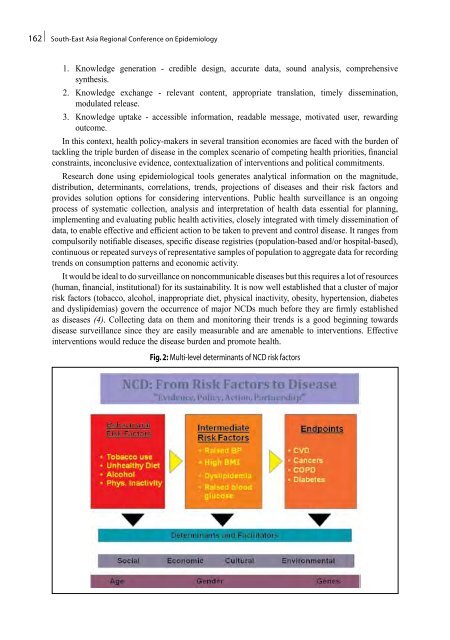South-East Asia Regional Conference on Epidemiology
South-East Asia Regional Conference on Epidemiology
South-East Asia Regional Conference on Epidemiology
You also want an ePaper? Increase the reach of your titles
YUMPU automatically turns print PDFs into web optimized ePapers that Google loves.
162 | <str<strong>on</strong>g>South</str<strong>on</strong>g>-<str<strong>on</strong>g>East</str<strong>on</strong>g> <str<strong>on</strong>g>Asia</str<strong>on</strong>g> <str<strong>on</strong>g>Regi<strong>on</strong>al</str<strong>on</strong>g> <str<strong>on</strong>g>C<strong>on</strong>ference</str<strong>on</strong>g> <strong>on</strong> <strong>Epidemiology</strong><br />
1. Knowledge generati<strong>on</strong> - credible design, accurate data, sound analysis, comprehensive<br />
synthesis.<br />
2. Knowledge exchange - relevant c<strong>on</strong>tent, appropriate translati<strong>on</strong>, timely disseminati<strong>on</strong>,<br />
modulated release.<br />
3. Knowledge uptake - accessible informati<strong>on</strong>, readable message, motivated user, rewarding<br />
outcome.<br />
In this c<strong>on</strong>text, health policy-makers in several transiti<strong>on</strong> ec<strong>on</strong>omies are faced with the burden of<br />
tackling the triple burden of disease in the complex scenario of competing health priorities, financial<br />
c<strong>on</strong>straints, inc<strong>on</strong>clusive evidence, c<strong>on</strong>textualizati<strong>on</strong> of interventi<strong>on</strong>s and political commitments.<br />
Research d<strong>on</strong>e using epidemiological tools generates analytical informati<strong>on</strong> <strong>on</strong> the magnitude,<br />
distributi<strong>on</strong>, determinants, correlati<strong>on</strong>s, trends, projecti<strong>on</strong>s of diseases and their risk factors and<br />
provides soluti<strong>on</strong> opti<strong>on</strong>s for c<strong>on</strong>sidering interventi<strong>on</strong>s. Public health surveillance is an <strong>on</strong>going<br />
process of systematic collecti<strong>on</strong>, analysis and interpretati<strong>on</strong> of health data essential for planning,<br />
implementing and evaluating public health activities, closely integrated with timely disseminati<strong>on</strong> of<br />
data, to enable effective and efficient acti<strong>on</strong> to be taken to prevent and c<strong>on</strong>trol disease. It ranges from<br />
compulsorily notifiable diseases, specific disease registries (populati<strong>on</strong>-based and/or hospital-based),<br />
c<strong>on</strong>tinuous or repeated surveys of representative samples of populati<strong>on</strong> to aggregate data for recording<br />
trends <strong>on</strong> c<strong>on</strong>sumpti<strong>on</strong> patterns and ec<strong>on</strong>omic activity.<br />
It would be ideal to do surveillance <strong>on</strong> n<strong>on</strong>communicable diseases but this requires a lot of resources<br />
(human, financial, instituti<strong>on</strong>al) for its sustainability. It is now well established that a cluster of major<br />
risk factors (tobacco, alcohol, inappropriate diet, physical inactivity, obesity, hypertensi<strong>on</strong>, diabetes<br />
and dyslipidemias) govern the occurrence of major NCDs much before they are firmly established<br />
as diseases (4). Collecting data <strong>on</strong> them and m<strong>on</strong>itoring their trends is a good beginning towards<br />
disease surveillance since they are easily measurable and are amenable to interventi<strong>on</strong>s. Effective<br />
interventi<strong>on</strong>s would reduce the disease burden and promote health.<br />
Fig. 2: Multi-level determinants of NCD risk factors









